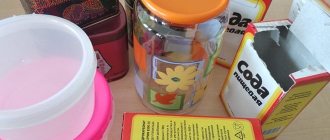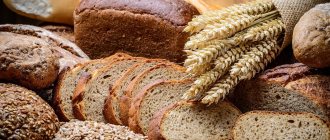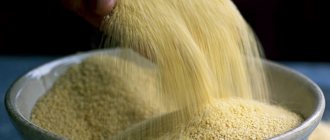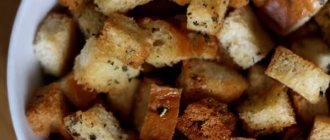When you bring a freshly baked loaf from the store, the kitchen is filled with a warm aroma. But the next morning the crust is no longer crunchy, and by the evening the crumb gives off the sourness of fermentation. A sure sign that in another day or two a “second” crust will appear. From mold. This is the result of improper storage.
Bread is a perishable product; purchasing it in reserve is not recommended. But there are still ways to keep your baked goods fresh throughout the week. And if you have a question about whether you can store bread in the refrigerator, remember - yes, you can. But it's better in the freezer compartment.
According to GOST
To control the quality of bakery products, a number of state standards and rules have been adopted:
- GOST 27842-88 “Bread made from wheat flour. Technical Specifications" contains requirements for various types of bread products, appearance, and organoleptic properties.
- GOST 27844-88 “Bakery products. Technical specifications” lists what chemical biological products must comply with, their appearance, and composition.
- GOST 2077-84 “Rye, rye-wheat and wheat-rye bread. Technical conditions".
- GOST 26983-2015 “Darnitsa bread. Technical conditions".
SanPiN 2.3.4.3258-15, which were in force until September 2015, have been cancelled, new ones have not been adopted.
Dear readers! To solve your problem right now, get a free consultation
— contact the lawyer on duty in the online chat on the right or call: +7 (499) 938 6124 — Moscow and region.
+7 (812) 425 6761 — St. Petersburg and region. 8 (800) 350 8362 - Other regions of the Russian Federation You will not need to waste your time and nerves
- an experienced lawyer will solve all your problems!
Breadbox
Usually housewives use a bread bin and keep in it all the bakery products that are available. But then you need to treat the inside of the bread box with vinegar at least once every 7-10 days. This will prevent the development of mold spores and harmful microorganisms.
Bread bins made of wood preserve baked goods for up to 3 days. They are quite hygroscopic and absorb some of the moisture of the baked goods, which leads to its rapid drying. If the bread bin is made of metal or plastic, the shelf life of the bread increases to 4 days, but later it will have a greater chance of becoming moldy than drying out.
To minimize the risk of mold forming on baked goods, the bread bin should not be placed in dark places with high humidity. It’s good if it is on the windowsill or table, away from the sink.
Baked goods will not go stale even after 5 days if you place a few pieces of sugar or peeled parts of an apple or raw potato in the bread bin next to it. This will create the microclimate necessary for storing baked goods, and the bread will remain fresh for a long time.
Dates and varieties
| Variety | Best before date | ||
| Breadbox (hours) | Refrigerator (days) | Freezer (monthly) | |
| White | 45 | 13 | 3 |
| Wheat | 24 | 13 | 3 |
| Borodinsky | 36 | 13 | 3 |
| Black | 36 | 13 | 3 |
| Rye | 36 | 13 | 3 |
| loaf | 24 | 13 | 3 |
| Buns | 48 | 13 | 3 |
| Harris | 60 days | 60 | 3 |
| Darnitsky | 48 | 13 | 3 |
| Home | 36 | 13 | 3 |
How to preserve bread while traveling
People often take baked goods with them on hikes. The rules for storing buns in such conditions will differ significantly from those at home:
- When choosing products, give preference to loaves in vacuum packaging, as they have a long shelf life.
- Do not open the packaging before putting things away; use it for its intended purpose once it is in place.
- When you need to cut off some bread, first divide the loaf into two parts, cut off the required amount, and pack it in a plastic bag, having previously released all the air from it.
Avoid prolonged contact of the product with sunlight and air. Make sure the bag is not wet.
What does this period depend on?
Shelf life depends on several factors:
- Package. In an effort to delay expiration, manufacturers package the product in paper, polyethylene, or film. Indeed, this method preserves its quality much longer and the bread does not go stale. It also allows the consumer to guarantee compliance with hygienic rules of transportation and storage on the store shelf. But even in this form, the natural product should be used within a week.
- Compound. Preservative substances, large concentrations, effectively increase the time of use - up to several months. The bread does not mold, but there is no need to talk about its benefits and naturalness. In addition, the yeast-free version lasts longer. Burgers spoil faster.
- Type of flour. The ingredient that undergoes the least processing, that is, coarse grinding, retains freshness longer and does not allow mold to grow.
- Conditions that do not meet the standards significantly shorten the shelf life. High humidity and temperature changes contribute to the growth of mold.
- Production technology also matters. If sanitary rules are not followed, the starter is not aged, or the baking temperature is too high or too low, the result will be too wet or dry. The first option will reduce, the second will increase the preservation of presentation and consumer properties.
The American product Harrys has a record long shelf life. It can be stored for up to 2 months. This result is easily explained: plastic packaging protects it from exposure to ambient air, bacteria, and personnel touches.
It also contains potassium propianate and food grade alcohol, which prevent mold from growing. It is clear that the manufacturer sacrifices beneficial properties and natural ingredients to extend the sales time.
ADVICE! It is recommended to use products with a short shelf life, since their composition is natural and the benefits for the body are maximum.
Other varieties spoil much faster. This is explained by the settling and proliferation of moldy fungi. They are present in the surrounding air, on pieces of furniture, and dishes, so an unpackaged loaf will inevitably collide with them.
The crumb is fertile soil for life and reproduction of microorganisms. After just a few days it is already completely ruined.
Requirements for the production of chemical products
Raw materials and additional materials can be used when baking bread only if they have appropriate quality certificates. Additives can be used in baking only if there is a hygienic certificate and permission for their use.
Raw materials are prepared in a special room or prepared department of the bakery shop. If the products used for kneading the dough arrived in a contaminated container, it must be cleaned before opening (for example, the bags are cleaned with a brush and only then ripped open at the seam). Containers that can be washed are washed and disinfected (cans, bottles, cans).
Neither containers nor raw materials can be stored in the work shop. All types of raw materials are transported (transported) only in closed containers! Flour, before preparing CBC, is necessary:
- sift;
- magnetize.
This is necessary to free it from impurities. Sugar, its substitutes and salt are dissolved and filtered for the same purpose.
Remember that a bakery shop for baked goods is not opened in a basement or semi-basement. The number of premises and their location must be such as to ensure the flow of raw materials and all processes. Raw materials and finished products should not “go out” through the same doors. At a minimum, you will need room for:
- bread production;
- grain storage;
- storage for raw materials (the enterprise must have at least a 7-day supply of products for preparing chemical products):
- changing room for staff;
- toilet with washbasin;
- room for storing cleaning equipment and spare parts for equipment.
the selected premises should be brought into compliance with SES standards. The same applies to equipment.
You can purchase a ready-made mini-workshop that will meet all the requirements for small bakeries.
Figure No. 2. An example of a mini-workshop for baking bread
Or buy the necessary equipment separately. But in any case, the units and their location must ensure the flow of work. Their surfaces must be made of a special material approved for direct contact with food.
To prepare the dough, you will need a full set of equipment if the entire preparation process is organized in this workshop. But the number of aggregates can be reduced if you use semi-finished dough.
Table No. 1. Equipment for bakers
| Set of equipment for working with semi-finished products | A set of equipment for performing a full cycle of work |
| Refrigeration equipment (freezer and refrigerator) | Devices for sifting flour |
| Dough proofing cabinets | Dough mixers |
| Dough proofing cabinets | |
| Furnaces | Furnaces |
| Add. equipment and inventory |
Storage
There are several ways to maintain freshness for a long time.
Packaged
The bakery product packaged by the manufacturer or store should be placed in a fresh, dry bag to prevent the formation of mold. You need to make several holes to allow air to pass through.
A linen towel is also a great option. It will protect against dampness and mold spores in the air, while allowing you to breathe.
If you have a bread bin, you need to adhere to certain rules:
- Wood is the best material, metal and ceramics are also suitable.
- Must be ventilated.
- It is not advisable to store black and white rolls together, it is better in different compartments or bags.
In a refrigerator
Refrigerator or freezer storage will also extend the shelf life. At a temperature of -18 °C the product can be stored for up to 3 months. However, each time it will have to be heated in the oven or microwave, the external and taste qualities will suffer. Repeated freezing and defrosting completely destroy the individual properties of the product.
Cold will slow down microbiological processes, which will extend the period of freshness. But you should know that you cannot put a product in the refrigerator that:
- Already spoiled. Mold will instantly spread to other products. Moreover, this is pointless, since a damaged product cannot be used.
- The packaging is completely sealed. The product becomes soggy and begins to deteriorate. It is necessary to make several holes for ventilation.
- Just baked. Hot foods should not be placed on the refrigerator shelf: the compressor may break.
Rules
- It is better to store bread at home in a bread bin. It is desirable that it be made of wood, but plastic and metal are also suitable. The best types of wood are birch bark and juniper. Mold avoids them.
- The main thing is that any bread bin has ventilation holes on the sides. Otherwise, the bread becomes soft, sticky and acquires an unpleasant odor.
- Wooden bread bins can become deformed in a damp room. Plastic ones are the most short-lived. Artificial ones are periodically treated with vinegar and dried, and crumbs are removed from them.
- Black and white bread are stored separately so that the microflora does not mix. Otherwise, the product will deteriorate much faster, especially white ones. In a wooden bread box it is better to keep it wrapped in linen cloth.
- If you place a piece of apple, potato, sugar or salt nearby to absorb excess moisture, the shelf life can be increased.
- You can use a regular waffle towel; paper, a plastic bag with holes made in it.
- The bread box can be replaced with an enamel container, but cover it with a lid. You can also put the above ingredients in it.
- Refrigerator storage helps a lot.
Important! When you bring the bread home, cut it down the middle before packing it and eat the slices from the middle first. And keep the remaining parts connected.
How to store it correctly so that it does not go stale?
According to nutritionists, fresh baked goods are harmful to the body due to the activity of gluten. It should lie for 1-2 days for the fermentation products to disappear.
- Store packaging should be replaced with a fresh dry bag. After all, manufacturers, as a rule, pack it while still hot. You need to make holes in the plastic packaging for ventilation.
- You can keep bread in the room if you plan to eat it quickly. Otherwise, a refrigerator is better.
- A paper bag – bread can be stored in it for a long time. The crust will even remain crispy, unlike polyethylene. The package must be tightly closed.
- A special bag with a special three-layer design - they can be purchased in supermarkets. They are designed for long-term storage.
Breadbox - it was already mentioned above.
Dishes - an enamel-coated pan or plastic will do. The main requirement is ventilation and lack of moisture.
The shelf life of bread is usually 3-5 days; bread prepared at home in a bread machine will last for more than a week. By the way, baked goods with vegetable oils last longer. It will have a maximum shelf life of 8-10 days.
We suggest watching a video on how to properly store bread so that it does not go stale:
Is it possible in the refrigerator?
Refrigeration will also increase shelf life. Cold will slow down the development of microbial flora.
To store bread in the refrigerator, you need to follow some rules:
- Do not put bread that is known to be spoiled in it. It will not recover, and the mold will spread to neighboring products.
- The packaging is absolutely sealed - this bread gets soggy and begins to deteriorate. You need to make several holes for ventilation.
- Do not store fresh baked goods. If it is not completely cooled, the refrigerator compressor may break down.
Important! The refrigerator helps keep bread fresh from 4 days to 2 weeks, but with proper packaging.
Is it possible in the freezer?
If you intend to preserve bread for a long time, you can use the freezing method. Both store-bought loaves and home-made loaves are stored in the freezer. Moreover, any: sourdough without yeast, yeast. The freezer will keep bread fresh from 18 days to six months. But first, the bread must be cut into pieces of the required size and each packed in foil or a bag.
If necessary, take out the required amount of bread. It can be defrosted naturally by placing it on the table, in the oven or in the microwave.
At low temperatures, starch recrystallization processes in bread stop – that’s why it doesn’t go stale for a long time. Repeated freezing is excluded.
What to do with expired bread
Expired bread usually means moldy or dried out bread. The first case has only one way out - recycling. The second is partial restoration of properties.
Can be softened if dry
If the loaf is dry and there is no mold on it, you can try to soften it, for example in the microwave. Under the influence of microwaves, the piece will become moist and soften. However, this state will not last very long: after a few minutes it will harden even more.
Can also be used as crackers. To do this, you will need to fry it in a frying pan or dry it until golden brown in the oven.
What to do if mold appears
IMPORTANT! Moldy must be disposed of; it is unacceptable to eat it.
You need to understand that mold spores cannot be killed by heat treatment, freezing, or drying. Substances that are formed when mold matures have a toxic effect on the human body. They can seriously poison and damage internal organs - lungs, liver, kidneys.
Implementation requirements
The rules for the sale of chemical products are described by special rules and GOST standards for the laying and storage of products. They sell goods both in individual packaging and without. Each type of product is supplied with a label indicating the name of the product and its weight. For advertising purposes, you can also indicate the manufacturer of the product.
If the product is individually packaged, it contains information about the energy value of the product, manufacturer, date of manufacture and sales dates.
Place the bread on a sales shelf, in a wall cabinet or basket. Usually the vertical type of display is used. Small baked goods and long loaves can be laid out in a heap.
Where to store flour products
Polyethylene is not the best container for storing bread.
It has long been customary to store bakery products in a bread bin. Here they preserve their positive properties well. Bread bins can be made from various materials. Wooden and plastic ones are especially popular. Of course, it is better to choose the first ones. Although their price may be higher, they are safer and more durable. Wood, being a natural material, protects the product from moisture. Plastic bread bins can have an unpleasant chemical smell, so you need to choose them very carefully.
In addition, the following containers for storing bread are quite common:
- fabric bags - natural material perfectly allows air to pass through and prevents mold. Bags for storing bread can be made of cotton or linen. Before use, they must be washed without powder, rinse aid or other detergents. The storage bag should have a tight tie;
- Paper bags are a good way to store baked goods. They are very suitable for crispy products. Paper does not provoke the formation of condensation, so the bread does not become soggy. Unfortunately, this method is a one-time use; you should not reuse the packages;
- fabric cutting is a method that our ancestors used. They simply wrapped the bread in natural fabric and left it for storage. Surprisingly, in such packaging their products remained fresh for up to 10 days. Most likely this was due to good ventilation;
- plastic bag - this type of packaging is most often used by manufacturers. It is, of course, quite convenient, but its safety remains in question. It is still not worth storing bread in it for a long time. Polyethylene does not allow air to pass through, so moisture can accumulate in the bag. It is best to transfer it to a normal safe container after purchasing bread in such a package. If this is not possible, then you definitely need to cut several small holes in the bag to create at least some ventilation;
- kitchen utensils - in the territory of the former USSR there are often housewives who are accustomed to storing bread in ordinary enamel pans. They explain this by saying that caring for such containers is quite simple. It can be washed under running water, wiped dry and used again.
When choosing containers and storage space, you should make sure that there are no pests. They can infect flour products, after which they become unfit for consumption. Therefore, if suspicion arises, it is necessary to thoroughly treat the bread storage cabinet and all other containers with a weak solution of acetic acid.
How to choose the right place in the kitchen
It is customary to keep bread in the kitchen. Coming from the store, any housewife puts food on the table. Then he places it in cabinets, drawers or containers. It is better to put the bread in a bread bin, or in a birch bark or wicker basket. These items should stand on the surface of a table or lower kitchen cabinet. The distance to the floor should be 1.2-1.5 meters.
It is not advisable to store food purchased in a store on a windowsill in direct sunlight. At this point they quickly deteriorate. You can put the baked goods in the refrigerator, on the middle shelf. The bread must first be placed in a plastic or paper bag.
Secrets of proper bread care
In order for the loaf to remain soft for a long time, the place where it is stored should be kept clean and air circulated with a minimum of moisture. How to take care of your bread storage:
- daily clean the inside of the container from crumbs by wiping the surface with a dry towel, you can use a paper napkin;
- wash the bread box weekly with soap and water (if the material allows), then treat it with a 1% solution of acetic acid and let it dry thoroughly;
- It is advisable to cover the bottom of the container with clean paper or cloth; they are changed once a week - the paper is thrown away, the cloth is washed.
If you use paper bags, discard them after using the loaf. Canvas bags for storing baked goods must be washed once a week after consuming their contents. Foil and polyethylene are also used once, and plastic containers or an opened enamel pan are treated with dishwashing detergent, after which they are rinsed well and wiped dry.
Bread can be called a unique product that people have baked since time immemorial. Thanks to technological progress, methods for preserving bread products are being improved, but you should not buy more bread than you can use. After all, even long-term storage in the refrigerator does not save the loaf from spoilage.
Share Like Share Tweet Pin
Summarize
Bread has a short shelf life at room temperature - only 3-7 days.
Proper sealing and storage, and using the refrigerator or freezer when necessary, can help prevent mold and increase shelf life.
If you see mold, you should throw away all the bread, as mold can produce harmful mycotoxins.
To prevent food waste, try creative ways to use up your old loaves—like making bread pudding or homemade croutons—before they expire.











